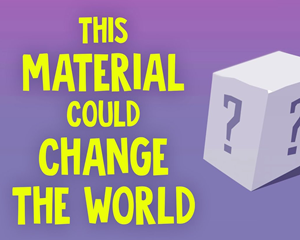Thousands of years ago, the Romans invented a material that allowed them to build much of their sprawling civilization.
几千年前,罗马人发明了一种得以让他们建设庞大文明的材料。
Pliny the Elder praised an imposing sea wall made from the stuff as "impregnable to the waves and every day stronger."
老普林尼夸赞一个由这种材料搭建的海堤称之为“坚不可摧,并且日益坚固”。
He was right: much of this construction still stands, having survived millennia of battering by environmental forces that would topple modern buildings.
他说的对,这建筑大半至今犹存,从会摧毁现代建筑的数千年的恶劣环境影响中存活下来了。
Today, our roads, sidewalks, bridges, and skyscrapers are made of a similar, though less durable, material called concrete.
今天的道路、人行道、桥和摩天大楼由类似、没有那么耐用的材料所制,叫做混凝土。
There's three tons of it for every person on Earth.
世上每个人有3吨混凝土。
And over the next 40 years, we'll use enough of it to build the equivalent of New York City every single month.
今后的四十年每个月的消耗量都足够建造一座纽约市。
Concrete has shaped our skylines, but that's not the only way it's changed our world.
混凝土塑造了我们地平线,但不局限于此。
It's also played a surprisingly large role in rising global temperatures over the last century,
混凝土还惊人地大大影响过去一个世纪的全球升温,
a trend that has already changed the world, and threatens to even more drastically in the coming decades.
这个趋势已经改变了世界,并且温度上升将会在未来加剧。
To be fair to concrete, basically everything humanity does contributes to the greenhouse gas emissions that cause global warming.
对混凝土公平一点,其实人类所有的行为都会促成温室气体排放,造成全球变暖。
Most of those emissions come from industrial processes we often aren't aware of, but touch every aspect of our lives.
绝大多数的排放源来自我们没察觉到却处处影响我们生活的工业活动。
Look around your home. Refrigeration -- along with other heating and cooling -- makes up about 6% of total emissions.
看看你的家。冰箱连同其他加热和制冷占了大约6%的总排放。
Agriculture, which produces our food, accounts for 18%. Electricity is responsible for 27%.
生产食物的农业占18%。电力占27%。
Walk outside, and the cars zipping past, planes overhead, trains ferrying commuters to work -- transportation, including shipping, contributes 16% of greenhouse gas emissions.
出去走走,驶过的车,头顶上的飞机,载着通勤的人们的火车—交通工具,包括船舶,占温室气体排放的16%。
Even before we use any of these things, making them produces emissions -- a lot of emissions.
甚至在我们使用这些东西之前,制造它们都会造成排放,很多排放。
Making materials -- concrete, steel, plastic, glass, aluminum and everything else -- accounts for 31% of greenhouse gas emissions.
制造材料--混凝土、钢铁、塑料、玻璃、铝和其他--占温室气体排放的31%。
Concrete alone is responsible for 8% of all carbon emissions worldwide.
单单混凝土便造成了全世界8%的碳排放量。
And it's much more difficult to reduce the emissions from concrete than from other building materials.
而且,想减少混凝土造成的排放要比其他的材料更难。
The problem is cement, one of the four ingredients in concrete. It holds the other three ingredients -- gravel, sand, and water -- together.
问题出在水泥身上,混凝土四种主要组成原料中的其中一种。水泥将其他三种原料--碎石,沙子和水粘在一起。
Unfortunately, it's impossible to make cement without generating carbon dioxide. The essential ingredient in cement is calcium oxide, CaO.
不幸的是,生产水泥的过程中是不可能不产生二氧化碳的。CaO氧化碳是生产水泥的核心成分。

We get that calcium oxide from limestone, which is mostly made of calcium carbonate: CaCO3.
我们从由CaCO3碳酸钙组成的石灰岩中提取氧化碳。
We extract CaO from CaCO3 by heating limestone. What's left is CO2 -- carbon dioxide.
通过加热石灰岩从CaCO3中提取CaO。剩下的便是CO2--二氧化碳。
So for every ton of cement we produce, we release one ton of carbon dioxide.
每生产一吨水泥便要排放一吨二氧化碳。
As tricky as this problem is, it means concrete could help us change the world a third time:
即便这个问题很棘手,这代表混凝土可以第三次改变世界,做法是:
by eliminating greenhouse gas emissions and stabilizing our climate.
减少温室气体的排放,并且使我们的天气更稳定。
Right now, there's no 100% clean concrete, but there are some great ideas to help us get there.
今天,没有100%洁净的混凝土,但有些帮助我们达到目的的好想法。
Cement manufacturing also produces greenhouse gas emissions by burning fossil fuels to heat the limestone.
制造石灰的过程中,燃烧化石燃料去加热石灰岩,还造成温室气体的排放。
Heating the limestone with clean electricity or alternative fuels instead would eliminate those emissions.
用清洁能源或者其他燃料加热石灰岩会去除这些排放。
For the carbon dioxide from the limestone itself, our best bet is carbon capture:
至于石灰岩自带的二氧化碳,最好的赌注便是碳捕获:
specifically, capturing the carbon right where it's produced, before it enters the atmosphere.
确切来说,在产生二氧化碳之处,于其进入大气层之前,将其捕获。
Devices that do this already exist, but they aren't widely used because there's no economic incentive.
现在有可以达到这种目的的装置,但是由于没有经济激励,它们的应用并不广泛。
Transporting and then storing the captured carbon can be expensive.
运输并且储存被捕获的碳非常昂贵。
To solve these problems, one company has found a way to store captured CO2 permanently in the concrete itself.
为了解决这些问题,一个公司找到了可以永久在混凝土里储存被捕获的二氧化碳的方式。
Other innovators are tinkering with the fundamental chemistry of concrete.
其他创新者们在利用混凝土的基础化学原理。
Some are investigating ways to reduce emissions by decreasing the cement in concrete.
有些人研究减少混凝土里面的水泥成分去减少排放。
Still others have been working to uncover and replicate the secrets of Roman concrete.
其他人仍旧在尝试揭露和复制罗马混凝土的秘密。
They found that Pliny's remark is literally true. The Romans used volcanic ash in their cement.
他们发现普林尼的赞美是正确的。罗马人在混凝土里加入了火山灰。
When the ash interacted with seawater, the seawater strengthened it -- making their concrete stronger and more long-lasting than any we use today.
当火山灰与海水发生反应,海水使火山灰变得更坚固--比任何今天所使用的混凝土都更坚固和持久。
By adding these findings to an arsenal of modern innovations, hopefully we can replicate their success
把这些新的发现加入到现代的创新者们的宝库里,希望我们可以复制他们的成功,
both by making long lasting structures, and ensuring our descendants can admire them thousands of years from now.
不仅建造更加持久的建筑,还确保我们的后代在几千年后仍能够敬仰它们。


